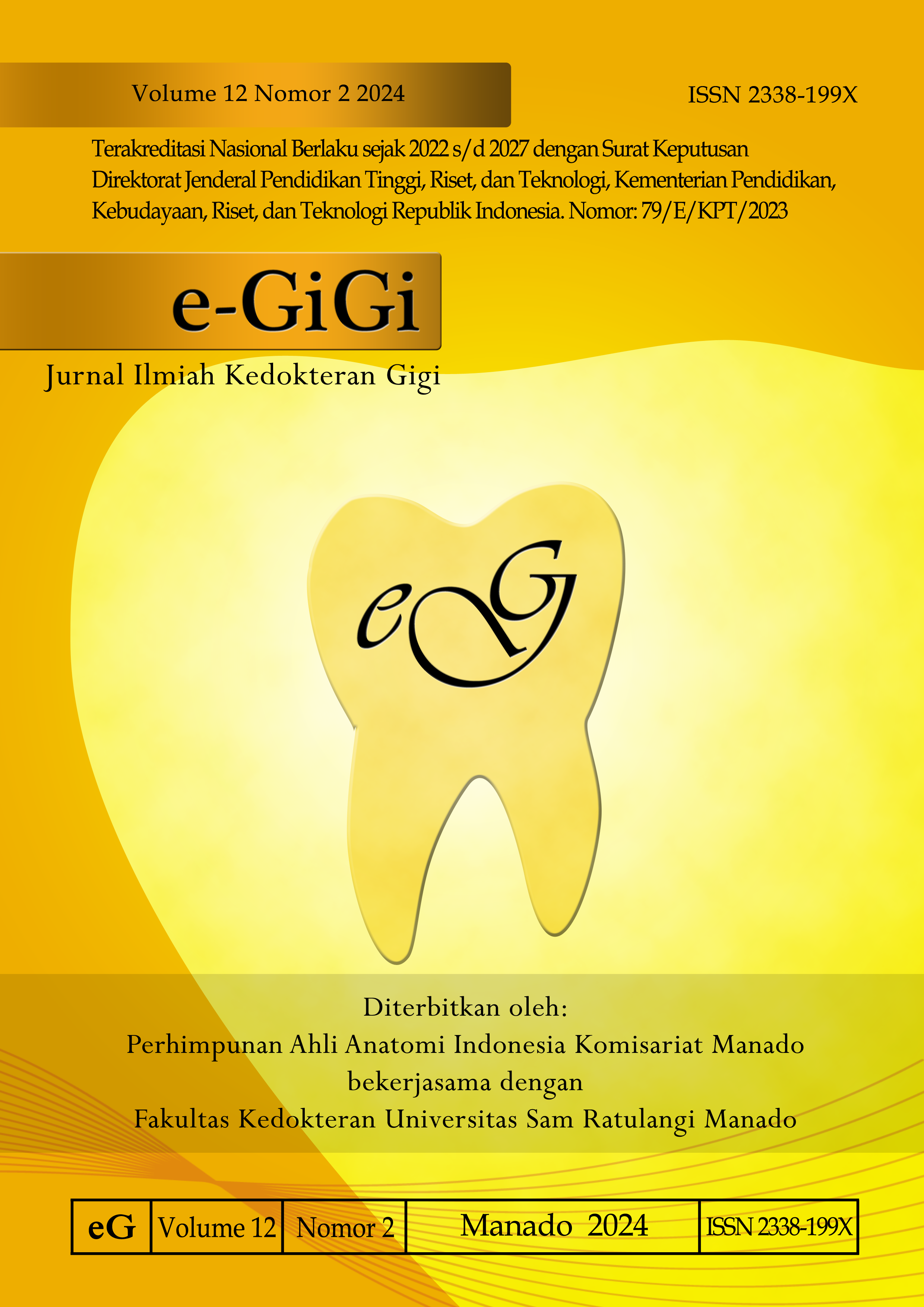Kekasaran Permukaan Plat Resin Akrilik dengan Pemolesan Menggunakan Serbuk Cangkang Bekicot (Lissachatina Fulica)
DOI:
https://doi.org/10.35790/eg.v12i2.51944Abstract
Abstract: Acrylic resin material is often used in making dentures because the color is similar to gingiva, easy to process, small dimensional changes, and relatively cheap price. One of the conditions that must be met is that the final product is easy to polish. Snail shell can be used as an abrasive for polishing acrylic plates because it contains protein, phosphorus and calcium. This study aimed to find out whether snail shell (Lissachatina fulica) powder as an abrasive material could reduce the roughness of acrylic surfaces. This was a laboratory and experimental study. Samples of acrylic resin plates were divided into three groups, group A was polished using sandpaper, group B was polished using pumice, and group C was polished using snail shell powder. Each group had nine samples of acrylic resin plates. Surface roughness of samples was tested with scanning electron microscope (SEM). The results showed that the surface of group C samples was the smoothest compared to the other groups tested with SEM. In conclusion, snail shell (Lissachatina fulica) powder can be used as an abrasive material to reduce the roughness of acrylic surfaces.
Keywords: snail shell; surface roughness; acrylic resin plate
Abstrak: Bahan resin akrilik sering digunakan dalam pembuatan gigi palsu karena warnanya mirip dengan gingiva, mudah diolah, perubahan dimensi kecil, dan harganya relatif murah. Salah satu syarat yang harus dipenuhi ialah produk akhir mudah dipoles. Cangkang bekicot dapat digunakan sebagai abrasif untuk memoles pelat akrilik karena mengandung protein, fosfor dan kalsium. Penelitian ini bertujuan untuk mengetahui apakah cangkang bekicot (Lissachatina fulica) sebagai bahan abrasif dapat mengurangi kekasaran permukaan akrilik. Sampel pelat resin akrilik dibagi menjadi tiga kelompok, kelompok A dipoles menggunakan amplas, kelompok B dipoles menggunakan batu apung, dan kelompok C dipoles menggunakan serbuk cangkang bekicot. Setiap kelompok memiliki sembilan sampel pelat resin akrilik. Kekasaran permukaan sampel diuji dengan scanning electron microscope (SEM). Hasil penelitian menunjukkan bahwa permukaan sampel golongan C paling halus dibandingkan dengan kedua kelompok lainnya. Simpulan penelitian ini ialah serbuk cangkang bekicot (Lissachatina fulica) dapat digunakan sebagai bahan abrasif.
Kata kunci: cangkang bekicot; kekasaran permukaan; plat resin akrilik
References
Kementerian Kesehatan RI. Hasil Riset Kesehatan Dasar (RISKESDAS). Jakarta: Badan Penelitian dan Pengembangan Kesehatan Kementerian RI; 2018.
Winardhi A, Saputra D, Puspitasari D. Perbandingan nilai kekasaran permukaan resin termoplastik poliamida yang direndam larutan sodium hipoklorit dan alkalin peroksida. Jurnal Kedokteran Gigi. 2017;1(1):45-9. Doi: https://doi.org/10.20527/dentin.v1i1.336
Combe EC. Sari Dental Material. Alih Bahasa: Tarigan S. Jakarta: Balai Pustaka 1992. p. 211.
Anusavice KJ, Shen C, Rawls HR. Phillips’ Science of Dental Materials (12th ed). St Louis; Saunders; 2013. p. 61, 474-5, 481-91.
McCabe JF, Walls AWG. Applied Dental Materials (9th ed). Oxford: Blackwell Publishing Ltd; 2008. p. 113.
Indriana S, Syafrinani. Pengaruh bahan poles terhadap kekerasan permukaan basis nilon termoplastik. B-Dent FKG Universitas Baiturrahman. 2020;7(1):1-10. Doi: https://doi.org/10.33854/jbd.v1i1.275.g248
Kurniawan E, Asril A, Ningsih JR. Sintesis dan karakterisasi kalsium oksida dari limbah cangkang bekicot (Achatina fulica). Jamb J Chem. 2019;1(2):50-4. Doi: https://doi.org/10.34312/jambchem.v1i2.2453
Setiawan Y. Perbedaan kekasaran permukaan basis resin akrilik polimerisasi panas menggunakan bahan pumis, cangkang telur dan pasta gigi sebagai bahan poles [Skripsi]. Medan: Universitas Sumatera Utara; 2017.
Saputra L, Rakhmah N, Pradita HT, Sunardi. Produksi biodiesel dari minyak jelantah dengan cangkang bekicot (Achatina fulica) sebagai katalis heterogen. Prestasi. 2012;1(2):118-24.
Qoniah I, Prasetyoko D. Penggunaan cangkang bekicot sebagai katalis untuk reaksi transesterifikasi refined palm oil. Prosiding Skripsi Semester Genap 2010/2011 Fakultas Matematika dan Ilmu Pengetahuan Alam. Surabaya: Institut Teknologi Sepuluh Nopember; 2010.
Widiyanisma SS. Perbedaan kekasaran permukaan resin akrilik headcured pada pemolesan menggunakan bahan abrasif pumice dan bubuk cangkang kerang (Anadara Granosa)[Tesis]. Malang: Universitas Brawijaya; 2018.
Hariyanto YA, Mujiyanti T, Nasikhah H. Ekstraksi dan karakterisasi CaO berbasis cangkang bekicot dari Ponggok Blitar sebagai raw material biokeramik. Tranmisi. 2021;17(1):126-31. Doi: 10.26905/jtmt.v17i1.5200
Turhan Ş, Gunduz L. Determination of specific activity of 226Ra, 232Th and 40K for assessment of radiation hazards from Turkish pumice samples. Journal of Environmental Radioactivity. 2008; 99(2):332-42. Doi: 10.1016/j.jenvrad.2007.08.022
Hanna BA. Al-Majeed AEA. Abdulrazaak W. Effect of different dental materials on the surface roughness of acrylic resin (A comparative in vitro study). Marietta Daily Journal. 2008;5(3):281-5. Available from: https:// www.iasj.net/iasj/download/a07ca662264c6d60
Downloads
Published
How to Cite
Issue
Section
License
Copyright (c) 2024 Mara Gustina, Eka R. Efrata, Herlambang Prehananto

This work is licensed under a Creative Commons Attribution-NonCommercial 4.0 International License.
COPYRIGHT
Authors who publish with this journal agree to the following terms:
Authors hold their copyright and grant this journal the privilege of first publication, with the work simultaneously licensed under a Creative Commons Attribution License that permits others to impart the work with an acknowledgment of the work's origin and initial publication by this journal.
Authors can enter into separate or additional contractual arrangements for the non-exclusive distribution of the journal's published version of the work (for example, post it to an institutional repository or publish it in a book), with an acknowledgment of its underlying publication in this journal.
Authors are permitted and encouraged to post their work online (for example, in institutional repositories or on their website) as it can lead to productive exchanges, as well as earlier and greater citation of the published work (See The Effect of Open Access).






